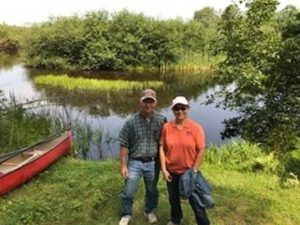
Byron Boettcher, a crop adjuster, and Deb Esselman, county executive director, head out on Mole Lake to look at the Sokaogon Chippewa Community’s wild rice.
By Kim Iczkowski, Wisconsin FSA Public Affairs and Outreach Coordinator
A thousand years ago, ancestors of the Sokaogon Chippewa Community migrated from eastern Canada to Forest County, Wisconsin.
Stories passed from one generation to the next, detailing how the tribe was led to the area by a vision of their journey ending in a land where the “food grows on water.” Today, the Sokaogon Ojibwe of Mole Lake continue to harvest that food, Manoomin, also known as wild rice, on one of the few remaining wild rice beds in the state of Wisconsin.
Manoomin is a priceless food source culturally linked to the communities past, present and future. As is true with many crops, wild rice is susceptible to extreme weather events. Average years are expected, while poor years can be devastating. To provide a safety net for their annual wild rice crop, the Sokaogon Chippewa Community enrolled in the USDA Farm Service Agency’s (FSA) Noninsured Crop Disaster Assistance Program (NAP).
NAP provides financial assistance to producers of noninsurable crops to protect against natural disasters that can result in lower yields or crop losses and covers instances where the crop is prevented from planting.
“We appreciate the time that the tribe has spent teaching us about the crop that is so important to many aspects of their community. It has been a learning experience for us from start to finish,” said Deb Esselman, FSA county executive director. “The first thing we had to do was figure out how to call a lake a “field” in our computer system. With the tribe’s cooperation, we have learned together and economically insured this important crop.”
The wild rice crop is unique to the NAP program from start to finish. The “field” is a 180-acre lake that is reported on their annual acreage report to their local FSA office. To determine Actual Production History (APH) for the NAP program, an annual appraisal is completed by, Byron Boettcher, a crop adjuster for FSA.

Once harvested, the Sokaogon Chippewa community members use the rice for ceremonies, daily meals, feasts, and community gatherings.
“I have really enjoyed the opportunity to work with the Sokagon Chippewa Community,” said Boettcher. “It has been a great experience to learn about this crop and its unique harvest method.”
To perform an appraisal, Boettcher uses a canoe and guide service provided by the tribe’s biologist. The appraisal process is similar to traditional grain crops, except the field is on water rather than soil.
Once harvested, the Sokaogon Chippewa community members use the rice for ceremonies, daily meals, feasts, and community gatherings. The tribe’s natural resources department will purchase rice to help reseed areas of the lake that weren’t as successful.
In addition to working with the local FSA office, the Natural Resources Conservation Service (NRCS) worked with the Sokaogon Chippewa Community from 2008 to 2013 to restore the wild rice beds on the lake.
NRCS committed Wildlife Habitat Incentive Program (WHIP) funds to the project. The work was made possible through a previous collaboration between the Chippewa Tribes and the Great Lakes Indian Fish and Wildlife Commission (GLIFWC). This collaboration resulted in the development of an NRCS conservation practice standard for wild rice restoration.
The tribe appreciates working with USDA and looks forward to the partnership for years to come.
For more information on USDA programs, visit farmers.gov or contact your local FSA office.





